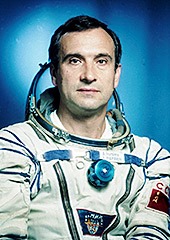Valeri Polyakov
Russian - (RFSA)
Deceased
Date of Birth: April 27, 1942
Date of Death: Sept. 19, 2022
Valeri Vladimirovich Polyakov (Russian: Валерий Владимирович Поляков, born Valeri Ivanovich Korshunov on April 27, 1942) is a former Russian cosmonaut. He is the holder of the record for the longest single stay in space in human history, staying aboard the Mir space station for more than 14 months (437 days 18 hours) during one trip. His combined space experience is more than 22 months. Selected as a cosmonaut in 1972, Polyakov made his first flight into space aboard Soyuz TM-6 in 1988. He returned to Earth 240 days later aboard TM-7. Polyakov completed his second flight into space in 1994–1995, spending 437 days in space between launching on Soyuz TM-18 and landing on TM-20, setting the record for the longest time continuously spent in space by an individual in human history.
Soyuz-U2 | Soyuz TM-6
Soviet Space Program | RussiaBaikonur Cosmodrome, Republic of Kazakhstan
Aug. 29, 1988, 4:23 a.m.
Status: Success
Mission:
Soyuz TM-6 was the sixth mission to Mir space station. The mission began on June 7, 1988, 14:03:13 UTC, launching Commander Vladimir Lyakhov, Flight Engineer/Research Doctor Valeri Polyakov and Research Cosmonaut Abdul Mohmand, the first Afghan cosmonaut, into orbit. They docked with Mir two days later, meeting with the long-duration resident crew. During their 7-day stay there, cosmonauts performed Earth observation and other tasks. They returned on a Soyuz TM-5 spacecraft, landing safely back on Earth on September 7, 1988, 00:49:38 UTC.
Low Earth OrbitSoyuz-U2 | Soyuz TM-7
Soviet Space Program | RussiaBaikonur Cosmodrome, Republic of Kazakhstan
Nov. 26, 1988, 3:49 p.m.
Status: Success
Mission:
Soyuz TM-7 was the seventh mission to Mir space station. The mission began on November 26, 1988, 15:49:34 UTC, launching Commander Alexander Volkov, Flight Engineer Sergei Krikalyov and Research Cosmonaut Jean-Loup Chrétien. They docked with Mir two days later, meeting with the resident crew. While Jean-Loup Chrétien returned 3 weeks later, two other cosmonauts were a part of the fourth long-duration expedition on Mir. During their stay there, cosmonauts performed an EVA and various experiments in biology, medicine, X-ray astronomy, technology etc. They also carried out sky surveys, spectrographic and topographic Earth observation experiments. Crew were visited by three Progress resupply spacecrafts. Jean-Loup Chrétien returned to Earth on December 21, 1988 in a Soyuz TM-6 spacecraft. The long-duration expedition crew returned on a Soyuz TM-7 spacecraft, landing safely back on Earth on April 27, 1989, 02:57:58 UTC.
Low Earth OrbitSoyuz-U2 | Soyuz TM-18
Soviet Space Program | RussiaBaikonur Cosmodrome, Republic of Kazakhstan
Jan. 8, 1994, 10:05 a.m.
Status: Success
Mission:
Soyuz TM-18 was the 18th mission and the 15th long-duration expedition to Mir space station. The mission began on January 8, 1994, 10:05:34 UTC, launching Commander Viktor Afanasyev, Flight Engineer Yury Usachov and Research Cosmonaut Valeri Polyakov into orbit. They docked with Mir two days later. During their stay there, cosmonauts carried out various scientific experiments in medicine, material sciences, astrophysics etc. Station crew was visited by several Progress resupply spacecrafts, and welcomed aboard the Soyuz TM-19 crew. The mission concluded with a safe landing back on Earth on July 9, 1994, 10:32:35 UTC.
Low Earth OrbitSoyuz-U2 | Soyuz TM-20
Soviet Space Program | RussiaBaikonur Cosmodrome, Republic of Kazakhstan
Oct. 3, 1994, 10:42 p.m.
Status: Success
Mission:
Soyuz TM-20 was the 20th mission and the 17th long-duration expedition to Mir space station. The mission began on October 3, 1994, 22:42:30 UTC, launching Commander Alexander Viktorenko, Flight Engineer Yelena Kondakova and Research Cosmonaut Ulf Merbold into orbit. They docked with Mir two days later. During their stay there, cosmonauts performed two EVAs, carried out various scientific experiments. Station crew was visited by several Progress resupply spacecrafts, and welcomed aboard the Soyuz TM-21 crew. During this mission the first rendezvous maneuver of the Space Shuttle STS-63 with the Mir space station was performed. The mission concluded with a safe landing back on Earth on March 22, 1995, 04:04:05 UTC.
Low Earth OrbitThe Roscosmos State Corporation for Space Activities, commonly known as Roscosmos, is the governmental body responsible for the space science program of the Russian Federation and general aerospace research. Soyuz has many launch locations the Russian sites are Baikonur, Plesetsk and Vostochny however Ariane also purchases the vehicle and launches it from French Guiana.
Electron
Raise and Shine (RAISE-4)
Rocket Lab Launch Complex 1B - Rocket Lab Launch Complex 1, Mahia Peninsula, New ZealandRAISE-4 (RApid Innovative payload demonstration Satellite-4) is a Japan Aerospace Exploration Agency (JAXA) satellite for on-orbit demonstrations of …
Kuaizhou 11
DEAR-5
Launch Area 95A - Jiuquan Satellite Launch Center, People's Republic of ChinaDEAR-5 is a commercial in-orbit payload and micro-gravity experiments hosting spacecraft developed by Chinese commercial company AZSPACE for various …
Long March 12
SatNet LEO Group 16
Commercial LC-2 - Wenchang Space Launch Site, People's Republic of ChinaA batch of Low Earth Orbit communication satellites for the Chinese state owned SatNet constellation operated by the China Satellite Network Group. …
Falcon 9
Starlink Group 6-90
Space Launch Complex 40 - Cape Canaveral SFS, FL, USAA batch of 29 satellites for the Starlink mega-constellation - SpaceX's project for space-based Internet communication system.
Falcon 9
Starlink Group 15-11
Space Launch Complex 4E - Vandenberg SFB, CA, USAA batch of 27 satellites for the Starlink mega-constellation - SpaceX's project for space-based Internet communication system.



